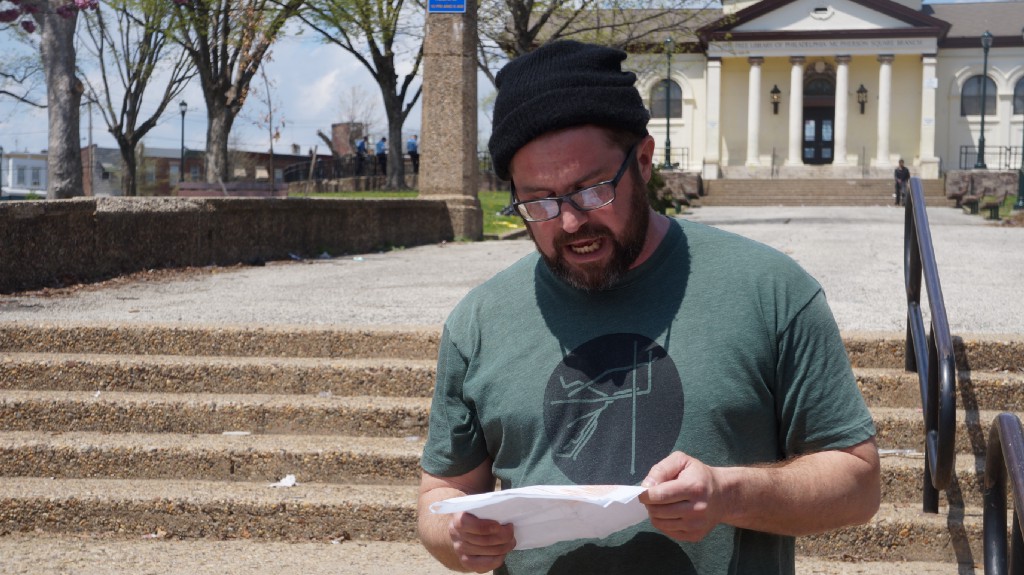“In one of my comp books I remember writing — in my own blood — ‘no more’ after doing a shot.”

“There is no way things are supposed to be. There’s just what’s in front of you and what you do with it.”
That’s a quote from a book. Paul Gorman forgets the name of the book, but that’s besides the point.
“When I read that, I was like ‘oh s,’” Gorman said while standing in front of the McPherson Square Branch of the Philadelphia Free Library. “On good days, that’s what I try to do most of the time. If you don’t, then you get to wake up the next day and [try] again.”
Gorman is sharing the story of his past addiction not just to the Star, but to about 30 of us who participated in Kensington Sidewalk Stories, a walking tour along Kensington Avenue from Lehigh Avenue to the McPherson Library.
The walking tour was put on by The Renegade Company, a South Philly-based theater company. The idea of Kensington Sidewalk Stories was Mike Durkin’s, the company’s creative director, who struggles with addiction in the form of alcoholism.
Gorman, who used writing as a way to cope with the stress of drug use, recited two poems he had written during the days he spent getting high.
One dealt with going through inpatient rehab.
“Corner of Lehigh and Frankford / Street profits screaming / Are you listening? / Meet me where I’m standing at / Lawn ornaments / Religious and Festive and the memory of / often the memories, memorials and celebrations come before the love” went the other.
“In one of my comp books I remember writing — in my own blood — ‘no more’ after doing a shot,” he said. “Because you get to the point where you just don’t know what to do but keep getting high. But you don’t want to keep doing it, and it’s just this vicious [cycle].”
Gorman was the last of four former users to share his story during the tour. Meg, Darlene and John Paul also told their stories during the walk (Meg and Darlene didn’t want their last names mentioned). Paul actually passed away recently, but Durkin, who led the tour, was able to get Paul to tell his story before he passed. He recorded it, and played the recording on a portable speaker during the tour.
Durkin called the tour, which was free of charge, a “work in progress” in an effort to gain feedback for a larger feature production planned for September. He hopes to hold another tour sometime in the summer to gain some more feedback — likely in June or July — before figuring out a plan for the feature release in September.
“It’s a work in progress to sort of test different ideas, different experiences and see how it all sort of just works together here,” he said. “It’s definitely a learning sort of place to see what things are resonating for folks.”
As the tour marched along Kensington Avenue, the “audience” experienced what Kensington Avenue is like on a typical Saturday afternoon. The group marched past the homeless encampment under the Conrail tracks, where they were exposed to the sights and sounds — and smells — that the community lives in on a daily basis.
It’s not pretty.
Puddles of both fresh and dried vomit lined the walls of the tunnel. It smelled like urine. As the group continued further, they witnessed an actual overdose. On his back, a man lied down on the sidewalk opposite of the walking tour. His baseball hat was on top of his chest. Two police officers stood beside him. Approximately two minutes later an ambulance showed up. This was not supposed to be part of the production, but, in a way, it was.
So were the incessant ambulance sirens and the rumble of the Market-Frankford Line El train pummeling its way through the neighborhood every few minutes.
The tour walked past a number of businesses you’d likely wouldn’t find in Old City, Fairmount, Rittenhouse Square, or a variety of other neighborhoods in the city. For instance, a car lot that sold cheap used cars all priced between $1,000 and $3,000. Another business sold only cheap used lawn mowers. People could be observed passed out on their stoops with a syringes clenched in their fists. Another man was talking on his phone, saying something about needing to get “some Xanies” while pacing frantically in front of a storefront.
“We’re not here to fabricate,” Durkin said of the atmosphere. “We’re showing that this is the slice of the neighborhood. So all of those things were in consideration as far as what this experience is like for people. To see in the tour how many times we’ve heard the ambulance go by, how many times we’ve heard the train go by. That’s the daily life. That’s what people endure. We wanted to have that relationship.”
The tour sheds a light upon the lives of good-hearted people who were able to beat their addiction — or are at least in the process of beating it. They serve both as a reminder and as a template for what current users can become.
But it also sheds a light upon the neighborhood itself, which, even with help from organizations like the city’s Department of Homeless Services and Prevention Point, is still desperately in need of adequate resources and funding to restore it to the way it’s supposed to be. Unfortunately, not all of those resources are within reach right now — all that’s there is what’s in front of you.
It’s just a matter of what you do with it.
For more information about Kensington Sidewalk Stories visit therenegadecompany.org. To get in touch with Durkin to give feedback or to obtain more information about future walking tours, which have yet to be scheduled, you can email him at [email protected].
